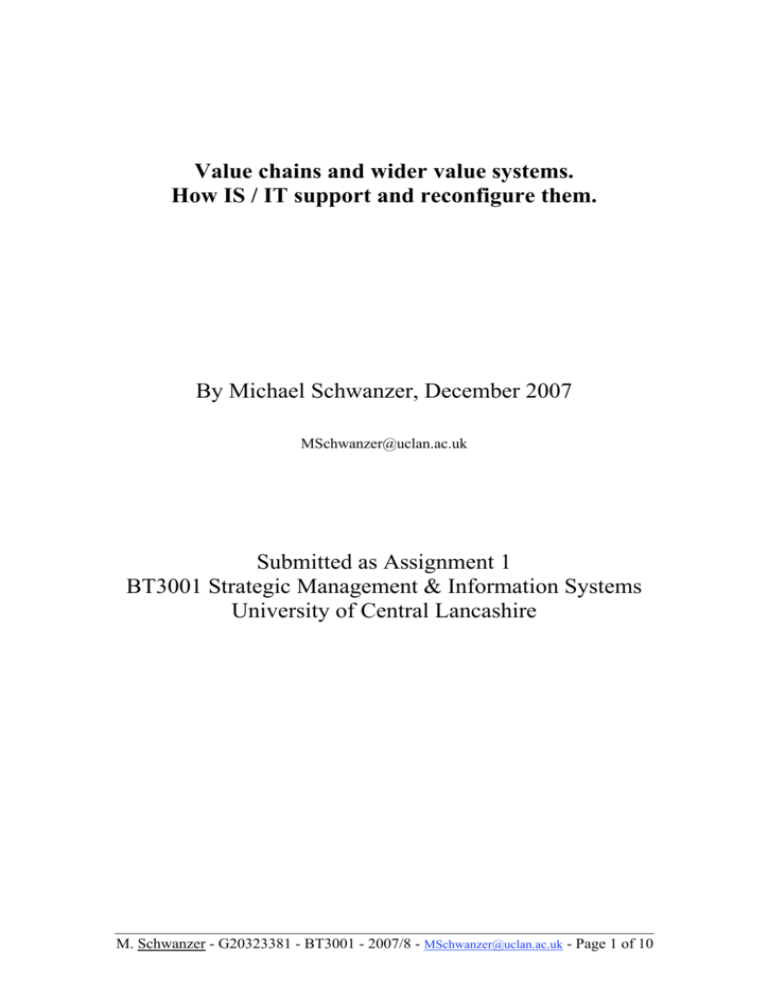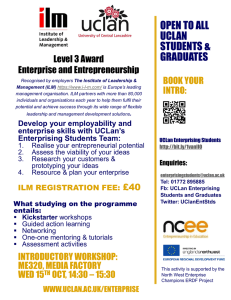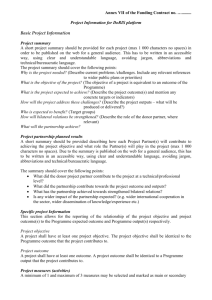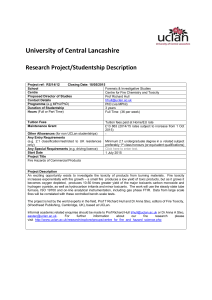Value Chain Analysis
advertisement

Value chains and wider value systems. How IS / IT support and reconfigure them. By Michael Schwanzer, December 2007 MSchwanzer@uclan.ac.uk Submitted as Assignment 1 BT3001 Strategic Management & Information Systems University of Central Lancashire M. Schwanzer - G20323381 - BT3001 - 2007/8 - MSchwanzer@uclan.ac.uk - Page 1 of 10 Table of Content 1. VALUE CHAIN CONCEPTS 3 1.1. INTRODUCTION 3 1.2. ACTIVITIES 3 1.3. WIDER VALUE SYSTEM / VALUE NETWORK 5 1.4. INTERNATIONAL VALUE NETWORKS 6 2. INFORMATION SYSTEMS / INFORMATION TECHNOLOGY 7 2.1. BHARAT PETROLEUM CORP. LTD. / ERP 8 2.2. UNITED STATES STEEL (USS) 9 BIBLIOGRAPHY AND REFERENCES 10 M. Schwanzer - G20323381 - BT3001 - 2007/8 - MSchwanzer@uclan.ac.uk - Page 2 of 10 1. Value chain concepts 1.1. Introduction The value chain within an organisation is an important part of it. By adding value to the product, the value chain supports achieving competitive advantage by delivering this value to the customers. Michael Porter (1985) described a concept of value chain analysis to help organisations to understand their value chains and in a wider context, value networks, which are described later in this work. Value chains do not only create and add value – it is also possible to loose value in a suboptimal process. According to Michael Porters concept, all activities involved in the process of the value chain are analysed and structured in a generic model with the margin of the product as output. 1.2. Activities Michael Porter separated the activities involved in the value chain in two groups. Also the cost of these value activities has to be evaluated to compare it with the value added at it, to find out if the activity could be improved. If costs are higher then the added value of an activity (for the customer), the organisation might has found a potential activity for improvements. Activities directly concerned into the process of creation or delivery of a product or service are called “primary activities”: Primary activities (five groups) • Inbound logistics (managing all inputs needed for the product or service, receiving, storing and distributing these inputs) • Operations (inputs are transformed into the product or service) • Outbound logistics (collect, store, distribute the product or service) • Marketing and sales (make possible customers or users aware or the product or service, advertisements for example) • Service (Enhancements and maintenance of the product or service) All of them are linked to “support activities” to improve their effectiveness or efficiency: Support activities (four areas) • Procurement (purchasing goods / input resources for primary activities) • Technology development (R&D, process development, key technologies) • Human resource management (recruiting, managing, training, developing and rewarding employees) • Infrastructure (All systems concerning finance, quality control, information management and planning) M. Schwanzer - G20323381 - BT3001 - 2007/8 - MSchwanzer@uclan.ac.uk - Page 3 of 10 Michael Porter illustrated these activities like this: Figure 1: The value chain within an organisation The advantage for organisations by using this approach of analysing value chains is that the performance of their activities could be identified. This could mean outsourcing of activities in which the organisation is not good at to gain competitive advantage. Therefore, managers examine cost and value of activities. All in all, the result of the linkage of all these activities is the profit margin. The more efficient the value chain of an organisation is, the cheaper the creation of the product or service is and therefore a better profit margin is possible. Managers should be able to identify clusters of activities providing particular benefit to customers, highlight activities, which are less efficient and they also have to think about the role of such activities. (Johnson, G. Scholes, K. & Whittington, R., 2006) M. Schwanzer - G20323381 - BT3001 - 2007/8 - MSchwanzer@uclan.ac.uk - Page 4 of 10 1.3. Wider Value System / Value Network Because it is unusual that organisations do every single activity of adding value to their product in-house, Michael Porter came up with value networks, which are also called wider value systems. These networks connect different value chains (inter-organisational) and build relations between them. By linking value chains from suppliers to organisations and finally to customers, the product or service (the value) is created. This approach is illustrated in Figure 2. Figure 2: The value network / wider value system All the value chains linked together to a value network are important to the competitive advantage of an organisation. That means that not only the internal value chain influences the profit margin of a product or service. Therefore, organisations have to analyse and evaluate their whole value network. According to Johnson, G. Scholes, K. & Whittington, R. (2006) it is very critical that organisations understand the bases of their strategic capabilities in relation to the wider value network. They have to ask themselves some key questions: • • • • • Where are cost and value created? (The value chain analysis helps identifying them) Which activities are vital / centrally important? (Strategic capability) Where are the profit pools? (Johnson, G. Scholes, K. & Whittington, R. (2006) defined profit pools like this: “Profit pools are the potential profits at different parts of the value network”. In other words, they are parts of the network that are more profitable than others because of differences in competitive intensity for example.) Make or buy? (Sometimes outsourcing activities is more efficient) Who are the best partners? (Relationships have to be developed) M. Schwanzer - G20323381 - BT3001 - 2007/8 - MSchwanzer@uclan.ac.uk - Page 5 of 10 1.4. International value networks Elements of an organisation’s value chain also can be located abroad. According to Kogut, R. (1985), organisations can improve the configurations of their value chains and value networks through such internationalisation. One possibility is to exploit differences between countries. • • • Cost advantages (cheap labour, communication costs, transportation costs, taxation, etc) Unique capabilities Characteristics of national locations (differentiated product offerings) Organisations gain competitive advantage by using these possibilities of international value networks. The generic models of value chains and wide value systems do not include Information Systems or Information Technology so far. Therefore, I will give some examples of how they are used to support value chain activities in the second part of this work. M. Schwanzer - G20323381 - BT3001 - 2007/8 - MSchwanzer@uclan.ac.uk - Page 6 of 10 2. Information Systems / Information Technology “The description of information systems as a "competitive weapon" became a cliché during the 1980s”, Lefebvre, E. & Lefebvre, L. (1996) Today, it is obvious that information systems support business operations. Figure 3 shows some possibilities used to support value chain activities. Figure 3: Possible IS / IT Support according to Lefebvre, E. & Lefebvre, L. (1996) Today there are a lot more ways IS and IT support value chains and reconfigure value networks. For example Enterprise Resource Planning Software (ERP), Customer Relationship Management Software (CRM) and Supply Chain Management Software (SCM) help organisations making their primary activities and support activities more efficient. Furthermore these Software Solutions also interact with value networks and therefore are mighty tools for organisations. According to Gartner Dataquest (2006) SAP ranks number one in all these enterprise software markets. SAP also is the worldwide market leader across all ERP categories. This includes HR management, financial management, enterprise asset management and manufacturing operations. But SAP is not the only solution provider to bring IS / IT into a value chain – also Oracle and Microsoft have their software packages. Because SAP is one of the big players of business solution providers, I will have a quick look at their feature set as an example how it is used to support value chain activities and value networks. Some modules for the SAP framework are: Financials and Controlling, Materials Management, Sales & Distribution, Production and Planning, Human Resources; M. Schwanzer - G20323381 - BT3001 - 2007/8 - MSchwanzer@uclan.ac.uk - Page 7 of 10 The flagship enterprise software of SAP is called SAP R/3, which is technically a client/server based software framework with many modules and possibilities of enhancement through its own proprietary language (ABAP). Before all these complex enterprise solutions came up, there was (and still is) Electronic Data Interchange (EDI) to enable inter-company communication between different applications. The idea was to reconfigure the wider value chain by transferring information more efficient with a standardised format. I think it is very interesting that smaller partners of the wider value chain often got forced to use EDI by larger trading partners to make the communication cheaper for the larger partner. 2.1. Bharat Petroleum Corp. Ltd. / ERP One example of a successful strategic transformation to an IS / IT solution is the Bharat Petroleum Corporation Ltd., Teltumbde, A., Tripathy, A. & Sahu, A. (2002), wrote about. This Indian refining company was embarked upon the implementation of an IS / IT system to gain better control over its operations because of the possibility of a partial privatisation. They chose SAP R/3 as their ERP system and projected cost savings of €7.5m per year. The goal was to transform the primary activities operations, inbound logistics, outbound logistics and customer services to information systems. Teltumbde, A., Tripathy, A. & Sahu, A. (2002) do not really mention if other activities of the value chain were involved in this transformation but I guess so because of the advantages they gain with the SAP solution. What was special at this case is that it was not only an IS / IT project. There were a lot more people from other departments involved to restructure the company to new business units. After some initial problems, the enterprise transformation was done after 24 months and Bharat Petroleum achieved 24 per cent sales growth in the year after completion of the project. In my opinion, this transformation was that successful because they did not only “buy” a SAP solution and told their employees to work with it from now on. What they did was developing their solution together with the people who have to use it (Human resources, Finance, IT, etc.). They did not actively reconfigure their wider value system but I think that such major improvements have an impact on suppliers and customers and therefore reconfigured their value network indirectly. M. Schwanzer - G20323381 - BT3001 - 2007/8 - MSchwanzer@uclan.ac.uk - Page 8 of 10 2.2. United States Steel (USS) This example is not based on a standard software solution like SAP but on U.S. Steel home grown software. Due to market pressure U.S. Steel had to make their value chain dramatically more efficient. Because it is a company with a long history of growing in different places, they had many inhomogeneous information systems, controlled locally. This results in a system, very difficult to maintain and uneasy to interconnect efficiently in the matters of IT. They analysed their value chain and evaluated their existing information systems and started improving it step by step. Existing IS subsidiaries and the IT department got help from external consultants and companies (Oracle for data management software) One step reconfiguring their wider value system was the use of the Internet to process data with their suppliers and customers. By making their own value chain more efficient with IS / IT, they improved the wider value system of the Ford Motor Company and saved their business relationship. A good example of the improvements of the process was the system used for tracking orders. U.S Steel and their customers did exactly now the status of each order at every time. That supported their value chain and reconfigured their wider value system because they gained competitive advantage by fulfilling orders more efficient for their customers. Furthermore, U. S. Steel started using IS / IT to support activities of their value chain. This included also their inventory system and warehousing. Together with their order fulfilment system they started forecasting their customers demands and therefore made their inventory system more efficient. As a result of all this IS / IT support and integration, they managed their entire supply chain through a single integrated system. What happened next is also worth mentioning: U.S. Steel created a subsidiary to generate additional revenue by setting up such integrated systems for other companies (not only in the steel industry). In my opinion, U.S. Steel is one of the best examples of the importance of IS / IT in value chains in general and how powerful they support the reconfiguration of existing value chains to gain competitive advantage. Without this integrated system they built, they would not be competitive any longer to countries with cheap labour. M. Schwanzer - G20323381 - BT3001 - 2007/8 - MSchwanzer@uclan.ac.uk - Page 9 of 10 Bibliography and References FSN Publishing Ltd. (2006) SAP is number one in ERP market according to Gartner http://www.fsn.co.uk/channel_enterprise_financials/news/sap_is_number_one_erp_in _market_according_to_gartner.htm (accessed 31/12/2007) Johnson, G. Scholes, K. & Whittington, R. (2006) Exploring Corporate Strategy: Text and Cases, Seventh Edition, Prentice-Hall Kogut, B. (1985) Designing global strategies: comparartive and competitive value added chains, Sloan Management Review Laudon, K. & Laudon, J. (2008) Management Information Systems, Can Information Systems Save U.S. Steel? http://wps.prenhall.com/bp_laudon_mis_9/0,10571,2102290-content,00.utf8.html (accessed 31/12/2007) Lefebvre, E. & Lefebvre, L. (1996) The Impact of Their Adoption on Small and Medium-sized Enterprises, IDRC http://www.crdi.ca/es/ev-9303-201-1-DO_TOPIC.html (accessed 31/12/2007) Porter, M. (1985) Competitive Advantage: Creating and Sustaining Superior Performance, Free Press Teltumbde, A., Tripathy, A. & Sahu, A. (2002) Bharat Petrolem Corporation Limited, Vikalpa M. Schwanzer - G20323381 - BT3001 - 2007/8 - MSchwanzer@uclan.ac.uk - Page 10 of 10







